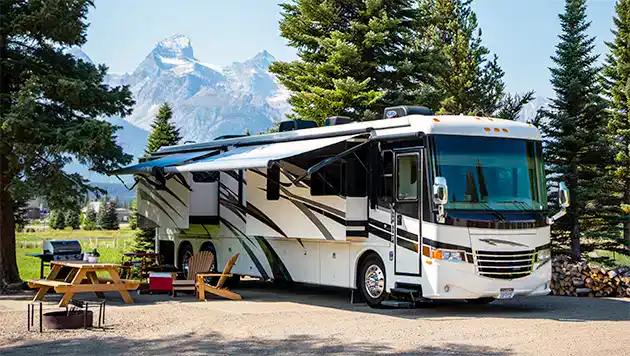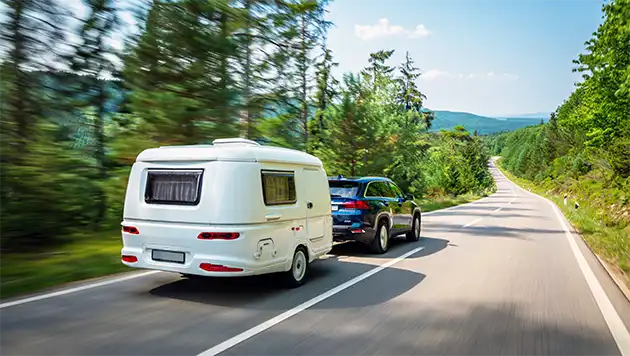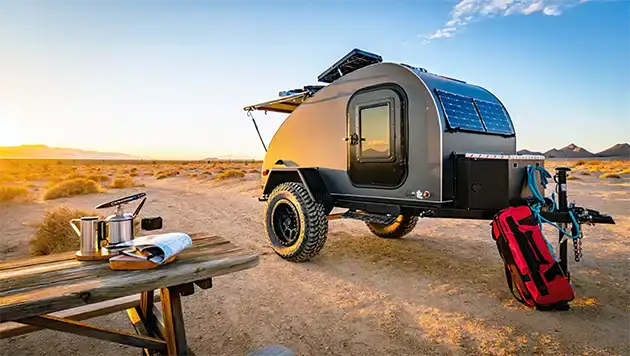
Thank you for reading our post, please rate this article at the end.
Reading Time: 12 minutesLast Updated on September 29, 2025 by Paul Clayton
Table of Contents
Choosing the Right RV for Your Lifestyle
Key Takeaways
-
- Prioritize Lifestyle Over Features: The best RV is the one that matches your travel frequency, group size, and trip duration. A smaller Class B or travel trailer is suitable for weekend camping, while a Fifth-wheel or Class A motorhome is better suited for long-term or full-time living due to its greater space and amenities.
- Understand RV Types:
- Motorhomes (A, B, C): Offer convenience as a single unit. Class A provides the most luxury/space, Class B offers flexibility/easy parking (ideal for campervans), and Class C balances comfort and drivability for families.
- Towables (Trailers, Fifth Wheels): Offer the flexibility of detaching from your tow vehicle. Fifth-wheels offer superior space and stability for extended stays, while travel trailers are more affordable and come in a wider range of sizes.
- Budget Beyond the Price Tag: Factor in ownership costs, such as insurance, registration, storage, and fuel. A used RV offers lower upfront costs but may require more immediate maintenance; a new RV has higher initial costs but includes a warranty.
- Essential Features for Comfort: Look for slide-outs to maximize living space when parked, and consider the size of the kitchen, bathroom setup (wet vs. dry bath), and the availability of ample storage solutions (both interior and exterior) based on your planned travel duration.
- Do Your Homework: Read user reviews and forums to find common issues with specific models. Visit RV shows and dealerships to experience floor plans in person, and always consider a certified RV inspection before purchase to avoid costly surprises.
Choosing the right RV comes down to matching our travel preferences with the type of RV that suits our lifestyle. The best RV for us is the one that balances comfort, budget, and travel style without adding unnecessary stress. By focusing on what matters most, whether that’s space for family trips, off-grid capability, or long-term living, we can narrow the options and avoid feeling overwhelmed.
As we explore the different RV types, we’ll see how each one serves a different purpose. A Class A motorhome offers spaciousness and luxury, while a travel trailer maintains simplicity and flexibility. Fifth-wheels, camper vans, and pop-ups each bring their own advantages and trade-offs. Understanding these differences helps us decide what really works for our plans.
We’ll also look at features, amenities, and costs that can make or break the experience. From floor plans and storage to maintenance and financing, every detail shapes how well an RV fits into our lives. By the end, we’ll have a clear path to choosing the right RV with confidence.
- Today’s Best Pop-Up Campers
- New vs. Used RV: Navigating the Price Trends
- Can You Rent an RV for a Year?
Identifying Your RV Lifestyle Needs
When choosing an RV, consider how often you plan to travel, where you want to go, who will be with you, and how long you expect to stay on the road. These factors shape the size, layout, and features that will make an RV practical and comfortable for our lifestyle.
Travel Frequency and Destinations
The frequency of our travel and the types of destinations we prefer play a major role in selecting the right RV. If we plan weekend trips to nearby campgrounds, a smaller travel trailer or pop-up camper may be enough. These are easier to tow and park, and they fit into most campsites.
For longer road trips across multiple states, motorhomes such as Class C or Class A models offer more storage and comfort. RV owners who enjoy staying at RV resorts or campgrounds may want larger rigs with hookups for water, electricity, and sewer.
On the other hand, if we value off-grid camping, we need features like solar panels, larger holding tanks, and generators. Choosing the right RV type depends on matching the vehicle’s capabilities with the environments we plan to visit most often.
Number of Travelers and Pets
The number of people and pets traveling with us directly affects the size and layout of the RV. Families often need bunk beds, multiple seating areas, and larger kitchens. Solo travelers or couples can manage with smaller Class B vans or compact trailers.
Pets also require consideration. Dogs may need space to move around, while cats may require a safe area for their litter box. Slide-outs can make the interior feel larger, but they also add weight and complexity.
We should also think about sleeping capacity. For example:
| Group Size | Suggested RV Type |
|---|---|
| 1–2 people | Class B, small travel trailer |
| 3–5 people | Class C, mid-size trailer |
| 6+ people | Fifth-wheel, large Class A |
Matching the RV to the group ensures everyone has enough room without overpaying for unused space.
Trip Duration and Living Preferences
Short trips require fewer amenities, but extended stays call for more comfort and storage. If we plan to live in an RV full-time, we may need larger appliances, multiple bathrooms, and reliable internet options. A fifth-wheel or Class A motorhome is often the best option for long-term living.
For shorter vacations, a smaller RV with basic features is usually enough. We should also consider how much maintenance we’re willing to handle. Larger rigs offer more space, but they also require more maintenance and higher repair costs.
Living preferences matter as well. Some of us want a residential feel with a full kitchen and entertainment system, while others prefer a simple setup that allows more time outdoors. Choosing based on how we expect to live day-to-day helps us avoid regrets later.
Overview of RV Types
When considering RVs, the primary differences revolve around size, mobility, and comfort. Some offer more living space and luxury, while others focus on affordability and flexibility for shorter trips. Understanding these differences helps us choose what best suits our travel style.
Motorhomes: Class A, B, and C
Motorhomes combine the vehicle and living space into one unit. Class A motorhomes are the largest and often the most luxurious. They resemble buses, can measure up to 45 feet, and feature amenities such as full kitchens, spacious bathrooms, and multiple slide-outs. These are ideal for long-term travel but can be difficult to park in smaller campgrounds.
Class B motorhomes, also known as campervans, are built on a van chassis. They are compact, easy to drive, and usually include a small kitchen, bed, and bathroom. While they have limited space, they are well-suited for couples or solo travelers who prefer flexibility and easier parking.
Class C motorhomes fall between the two. They are built on a truck or van chassis and are recognizable by the cab-over bunk. They offer more sleeping space than Class B and are easier to handle than Class A. Many families choose Class C for road trips because of the balance between comfort and drivability.
Travel Trailers and Fifth Wheels
Towable RVs offer us flexibility, as we can detach the trailer and use our vehicle separately. Travel trailers come in a wide range of sizes, from lightweight teardrops to 40-foot models. They are generally more affordable than motorhomes, but towing can be challenging for beginners.
Fifth wheels connect to a special hitch in the bed of a pickup truck. This design offers improved stability and additional interior space. Many fifth wheels include multiple bedrooms, large kitchens, and even washer-dryer setups. They are popular with full-time RVers who want a residential feel.
Key differences:
- Travel trailer: lighter, lower cost, wide variety of sizes
- Fifth wheel: heavier, requires a larger truck, more interior space
Pop-Up Campers and Campervans
Pop-up campers fold down for towing and storage, then expand at the campsite. They are lightweight, affordable, and can be towed by smaller vehicles. Inside, they usually include beds, a small kitchen, and sometimes a compact bathroom. Their biggest advantage is portability, but setup takes more effort compared to other RV types.
Campervans (often grouped with Class B motorhomes) are van-based RVs that maximize space with clever layouts. Many include solar panels, compact kitchens, and convertible beds. They are easy to drive in cities and on highways, making them popular with travelers who want mobility without towing.
Both options work well for weekend trips or shorter adventures. Pop-ups suit families on a budget, while campervans appeal to those who prefer simplicity and freedom of movement.
For more detailed comparisons of RV types, consider exploring guides such as this RV buying guide or this overview of towable RVs.
Comparing Features and Amenities
When it comes to RVs, the details matter. The right mix of living space, entertainment, and practical features, such as kitchens and storage, can make daily life on the road more comfortable and efficient.
Slide-Outs and Space Optimization
Slide-outs give us extra living space by extending sections of the RV outward when parked. This feature can turn a narrow hallway into a roomy living area or create space for a larger dining setup.
We should consider the number of slide-outs an RV has and their placement. A single slide might expand the main living room, while multiple slides can open both the kitchen and bedroom.
Key factors to check:
- Power vs. manual operation
- Weight impact on towing capacity
- Seals and insulation for weather protection
Slide-outs add comfort, but they also require regular maintenance. Regular checks on seals and moving parts help us avoid costly repairs.
Entertainment Systems and Connectivity
Modern RVs often feature entertainment systems that range from basic radios to comprehensive setups with large TVs, surround sound, and satellite services. For those of us working remotely or streaming media, connectivity is just as important as the hardware.
We should look for RVs with built-in Wi-Fi boosters, USB ports, and Bluetooth integration. These features make it easier to stay connected and keep devices charged.
Some RVs even offer outdoor entertainment centers with weatherproof speakers and TVs. This setup works well for families who enjoy movie nights or tailgating.
When comparing options, it helps to ask:
- Does the system support multiple devices?
- Is the wiring easy to upgrade in the future?
- Are there HDMI and Ethernet ports available?
Kitchen, Bath, and Storage Solutions
A well-designed kitchen can make long trips easier. Larger RVs may include residential-size refrigerators, ovens, and solid-surface countertops, while smaller ones often rely on compact appliances. We should consider how much cooking we plan to do while traveling.
Bathrooms also vary widely. Some RVs have a simple wet bath, while others feature full dry baths with separate showers. Families or full-time travelers may prefer larger layouts with extra storage.
Storage matters across the entire RV. Look for pantry space, under-bed storage, and exterior compartments. A good test is to imagine packing for a two-week trip. If everything fits without clutter, the RV’s design is practical.
For more detailed comparisons of layouts and features, guides like the RV buying guide explain how floor plans and amenities affect daily use.
Budgeting for Your RV Purchase
When planning to buy an RV, the cost extends beyond the sticker price. We need to consider whether a new or used RV is the best option for us and how much we’ll spend each year on upkeep, repairs, and other ownership expenses.
New vs. Used RVs
A new RV offers the latest technology, modern layouts, and the peace of mind that comes with knowing it has never been used before. Warranties often cover major issues for the first few years, which can reduce repair costs early on. However, new RVs tend to lose value quickly, especially within the first three years.
A used RV typically costs less upfront and may already include upgrades such as solar panels or towing equipment. The key is to check maintenance records and look for signs of wear. Buying from a dealer may offer limited warranties, while private sales often come “as-is.”
Here’s a quick comparison:
| Option | Pros | Cons |
|---|---|---|
| New RV | Warranty, latest features, no prior use | Higher cost, faster depreciation |
| Used RV | Lower price, possible upgrades included | Risk of hidden issues, limited warranty |
We should weigh these trade-offs based on our budget and comfort level with potential repairs.
Ownership Costs and Maintenance
Owning an RV means regular expenses beyond the purchase. We need to budget for insurance, registration, storage, and fuel. Larger RVs, such as Class A motorhomes, cost more to insure and maintain than smaller travel trailers.
Maintenance is another major factor. Routine tasks include roof sealing, tire replacement, and appliance servicing. Annual costs can range from a few hundred dollars for a small trailer to several thousand for a large motorhome.
Repairs can add up quickly. For example, replacing RV air conditioning may cost over $1,000. Choosing a used RV may save money upfront, but older units often need more frequent repairs.
We should also consider long-term expenses, such as upgrading batteries, replacing awnings, or maintaining slide-outs. Planning for these costs helps us avoid financial stress and enjoy the RV lifestyle with fewer surprises.
Researching and Evaluating RV Options
We need to gather reliable information before making a purchase. Looking at real user feedback, seeing RVs in person, and carefully testing them helps us make a choice that matches our budget, travel plans, and comfort needs.
Reading Reviews and RV Forums
Online reviews and RV forums give us insight into how different models perform over time. Owners often share details about fuel efficiency, maintenance costs, and how well layouts work for daily living. These experiences highlight issues that sales brochures rarely mention.
We should pay attention to repeated comments. If many people report problems with leaks, electrical systems, or towing stability, that’s a notable sign. At the same time, positive feedback about durability or customer support adds confidence.
It helps to compare multiple platforms. For example, manufacturer websites may highlight positive reviews, but independent forums or groups provide a wider range of honest opinions. Combining both perspectives gives us a balanced view.
Visiting RV Shows and Dealerships
RV shows let us see many models in one place. Walking through different floor plans helps us understand space, storage, and comfort in a way photos cannot. Large events like the Florida RV Supershow showcase a wide range of motorhomes and towables, making it easier to compare features side by side.
Dealerships also play an important role. We can ask questions about warranties, financing, and service options directly. Sales staff may highlight differences between similar models, which helps us narrow down choices.
To stay organized, we should take notes and photos during visits. Comparing details later prevents us from forgetting important differences. It’s also smart to ask about upcoming promotions or discounts, since timing can affect price.
Test Drives and Inspections
A test drive shows us how an RV handles on the road. We can check turning radius, braking, and acceleration, especially when merging onto highways. For towables, we should practice hitching and towing to see how stable the setup feels.
Inspections are just as important. We need to look for signs of water damage, inspect appliances, and test systems, including plumbing and electrical. Even new RVs can have issues that need to be addressed before purchase.
Hiring a certified RV inspector adds another layer of protection. They often spot problems we might miss, such as hidden leaks or weak seals. Spending a little on inspection can save us from expensive repairs later.
Making the Final Decision
We need to focus on how the type of RV fits our travel style and how well it can support us over time. Considering both our current needs and potential future changes helps us avoid costly mistakes and ensures we remain comfortable on the road.
Matching RV Type to Lifestyle
The right RV depends on how we plan to use it. If we want resort-style amenities, a Class A motorhome offers space and comfort but may not fit into smaller campgrounds. For shorter trips or easier parking, a travel trailer or pop-up camper may be a more practical option.
We should also consider group size. Families often require a fifth-wheel or Class C motorhome with multiple sleeping areas, while couples may prefer a Class B camper van for its flexibility and ease of driving.
Here’s a quick comparison:
| RV Type | Best For | Limitations |
|---|---|---|
| Class A | Long trips, luxury | High cost, limited campsite access |
| Class B | Couples, solo travel | Small living space |
| Class C | Families, mixed trips | Less storage than Class A |
| Fifth-Wheel | Extended stays | Requires a large tow vehicle |
| Travel Trailer | Weekend trips | It can be harder to tow |
We should match our lifestyle with these trade-offs rather than focusing only on features or price.
Planning for Future Needs
Our travel habits may change, so we need to think ahead. If we expect to take longer trips in the future, purchasing a slightly larger RV with more storage and stronger systems may save us from having to upgrade too soon.
Technology also matters. Features like solar panels, Wi-Fi boosters, and larger holding tanks can support off-grid camping, keeping us flexible. Choosing an RV with these options now helps us adapt later.
We should also ask: Will our family grow? Will we want to tow a car? Will we stay in RV parks or camp off-grid? Answering these questions now gives us a clear idea of what size, layout, and features will serve us best over time.
Considering both present and future needs ensures our RV remains useful and comfortable for years of travel.
Frequently Asked Questions
When choosing an RV, we need to consider how we plan to travel, the number of people joining us, and the level of comfort or flexibility we expect. Budget, size, and features also play a big role in finding the right fit for our lifestyle.
What factors should I consider when selecting an RV for full-time living?
We should focus on storage capacity, kitchen size, bathroom setup, and sleeping arrangements. Large holding tanks, reliable climate control, and durable construction are essential for long-term living on the road. A Class A motorhome or a fifth-wheel often works well due to their spaciousness and amenities.
How do I determine the best type of RV for my family’s travel needs?
We need to consider how many beds we require, whether we prefer a motorhome or towable RV, and how much space we want for dining and relaxing. Families often find that a Class C motorhome or a mid-size travel trailer provides a good balance of space and comfort.
What are the pros and cons of new versus used RVs?
A new RV gives us updated technology, modern layouts, and a factory warranty. However, it comes with higher upfront costs. A used RV typically costs less and may already come with upgrades, but it may require more maintenance and may not include a warranty.
How does the size and class of an RV impact its suitability for various travel plans?
Larger RVs, such as Class A motorhomes or fifth-wheels, offer more living space but may not fit in many state or national park campsites. Smaller RVs, such as Class B vans or pop-up trailers, are easier to drive, park, and take off-grid, but they offer less storage and fewer amenities.
What essential features should I look for in an RV to fit my outdoor adventure lifestyle?
If we plan to camp off-grid, we should consider investing in solar panels, a generator, and larger water tanks. Higher ground clearance and durable suspension help with rougher terrain. Compact RVs such as truck campers or rugged travel trailers are often designed with outdoor activities in mind.
How can I assess the quality and reliability of an RV before making a purchase?
We should inspect the roof, seals, and flooring for signs of leaks or damage. Testing appliances, plumbing, and electrical systems is also important. Reading reviews from other owners and checking maintenance records can help us assess the long-term reliability before making a purchase commitment.
Final Thoughts
Choosing the right RV is a decision that centers more on practical alignment with your specific travel goals than on luxury. By accurately assessing your needs, whether that means easy parking in a Class B, extensive space in a Fifth-wheel, or luxury in a Class A, you can confidently select a model that enhances your lifestyle rather than complicates it.
Thorough research, coupled with a realistic budget for ongoing maintenance, ensures your RV becomes a source of adventure and comfort for years to come.






